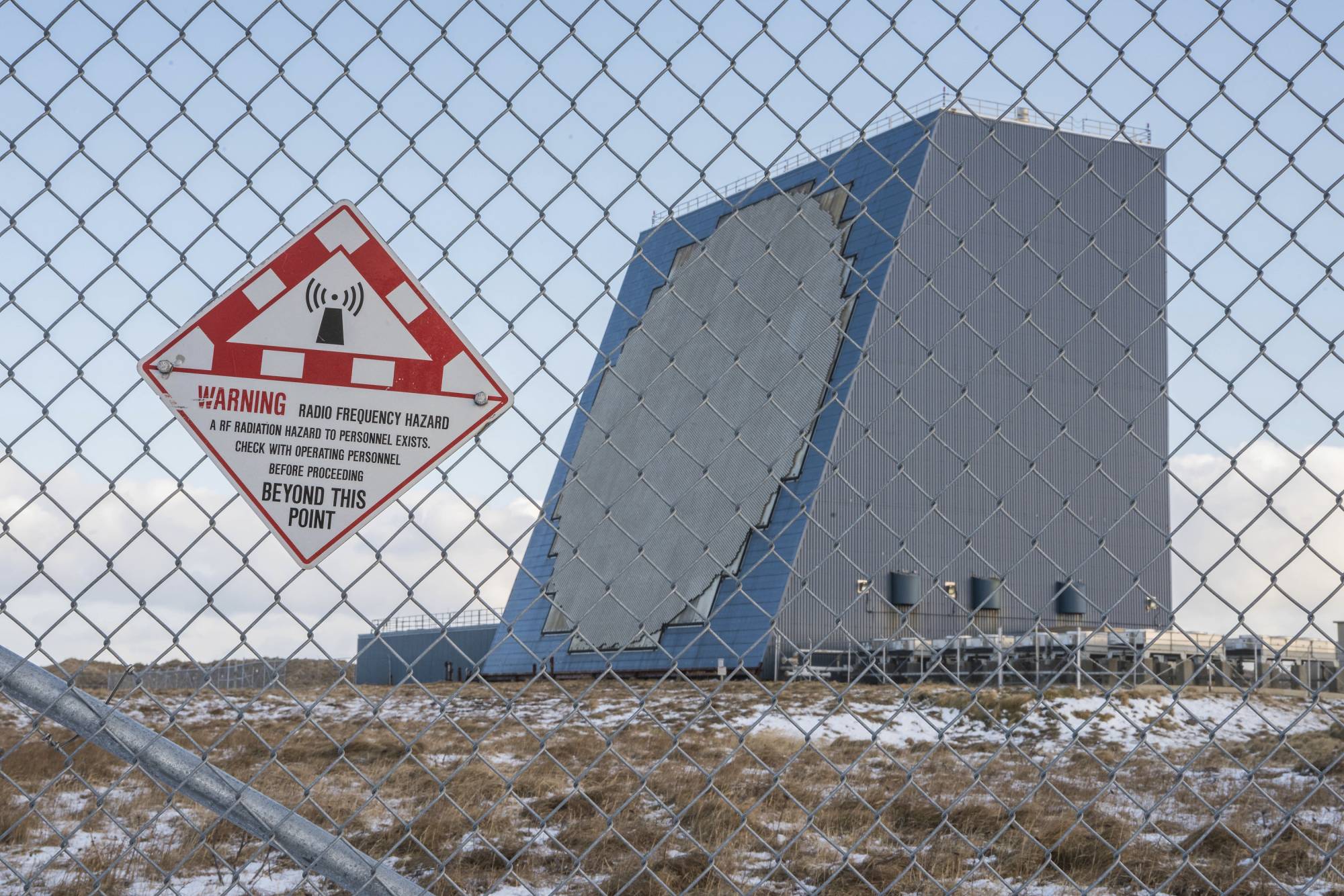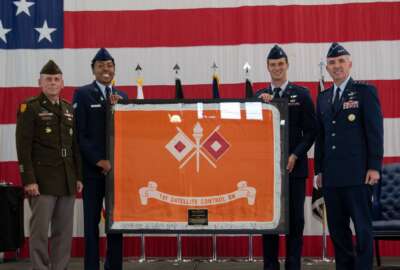
Army cultivating capabilities to protect space assets
The Army may operate primarily on the ground, but it relies on space communications to maintain freedom of movement and situational awareness and to guard against...
Best listening experience is on Chrome, Firefox or Safari. Subscribe to Federal Drive’s daily audio interviews on Apple Podcasts or PodcastOne.
The Army may operate primarily on the ground, but it relies on space communications to maintain freedom of movement and situational awareness and to guard against known and emerging missile threats. At the Association of the U.S. Army conference, the Federal Drive with Tom Temin got an update from the commander of the Army Space and Missile Defense Command, Lieutenant General Daniel Karbler.
Interview transcript:
Tom Temin: And I want to get right into it, ground based space integration and interdiction, and you have a 2030 vision for all of that. What is it all about?
Daniel Karbler: I do. So we look at space as a warfighting domain. And we recognize that in addition to air, land, sea, cyber spaces, just as an equal warfighting domain is all the traditional domains that we’re familiar with. We have got to make sure we recognize what the adversary can do through and in space, to disrupt our ability to move, shoot and communicate. We have to be able to counter that. And so any space interdiction capabilities that we have to protect our freedom to maneuver, our ability to communicate, and our ability to shoot is number one in my job jar. And then as the Army service component commander to support U.S. Space Command and General Jim Dickinson, we make sure that I provide him trained and ready forces to be able to do exactly that.
Tom Temin: And the space assets that the Army relies on are not all Army owned and operated. I mean, you rely on Space Force, Air Force, even commercial satellites. And so what’s the breakdown? And does the Army have its own space assets for its own purposes, maybe launched by somebody else?
Daniel Karbler: Now, it sure does. We have Army space assets. We have the First Space Brigade in Colorado Springs, and First Space Brigade has three battalions. And we have space assets in say 10 time zones, 22 different locations, and they provide support to Space Command, as well as Central Command and European Command. And those are Army space assets. Those are those are FA-40s. Those are space officers or space professionals. And then the enlisted force, though not a space [military occupation specialty], we draw heavily from signal corps, military intelligence and air defense. And they do everything from space control operations to theater missile warnings. So anytime that there’s any ballistic missile launch, they provide the early warning, the missile warning into a particular theater. And then we have our missile defense batteries, MDBs as we call them, and they are radar operators for our five strategic radars that support the ground-based midcourse defense system that defends North America from ICBM attack from North Korea or Iran.
Tom Temin: Right. That’s an important point because the Army has its needs for satellite comms to guide your own munitions, and to communicate on the ground and maneuver, and in the freedom to operate as you mentioned. But that defensive operation against incoming missiles, that also has a great reliance on space.
Daniel Karbler: It sure does, whether it’s the architecture and space to provide us with that early warning, and then provide that information to our sensors that are networked globally, that Missile Defense Agency provides us with that capability that our operators operate on. And then the communications aspect of it, again, global communications is all part of that global missile defense architecture that Space and Missile Defense Command soldiers operate from Colorado Springs, as well as our operators at Fort Greely, Alaska, with the interceptor field.
Tom Temin: And just give us a sense to the extent that you can of what’s going on up there, because all these nations now have space assets that didn’t have them 40, 50 years ago. We know China has offensive capabilities in space. Is it kind of a detente right now? You know, we’re all probing one another and trying to understand one another, but not taking lethal or destructive types of actions?
Daniel Karbler: Yeah, we recognize that the adversaries are contesting us in space. Absolutely. And so part of General Dickinson’s mission, his big mission is to make sure that the U.S. military has the opportunity to operate in, through and to space, as the combatant command First Space’s area of responsibility is 100 kilometers and above the surface of the earth. We provide him with, as the Army component, we provide him with the Army capabilities to do that.
Tom Temin: And is it possible to see other satellites? I mean, most satellites are designed to send information down, not so much between one another unless it’s a network of satellites. But I guess I’m asking you about the ability of one satellite to harm another one. Is that something you can see or be aware of?
Daniel Karbler: We’re always concerned with adversaries on orbit capabilities. And again, part of SPACECOM’s mission is to make sure that our orbit capabilities stay defended. And you mentioned, you know, can we see satellites? Part of our mission that I have with those strategic missile defense radars — so a missile defense radar that can see an incoming ballistic missile is also not too bad at being able to provide space domain awareness and look at those objects that are in space. And so that’s a unique part of our job is we’re able to provide the missile defense, you know, the sensors to provide missile defense sensing capabilities, as well as space domain awareness capabilities.
Tom Temin: And maybe talk more about the triad, the special operations and cyber command partnership that you have.
Daniel Karbler: Yeah, it’s just, to me, it’s a natural extension of combined arms operations. And when you read the Army’s FM 3.0 [operations manual] now that just got published about multi-domain operations, we’ve got to, you know, the traditional domains of air, land, sea, then the newer ones of cyber and space, have got to be treated just exactly the same as our other domains. And so the requirements to integrate our capabilities for the maneuver commander or the joint force commander are critical. And that stems everywhere from just the planning, before we’re executing a mission or campaign, all the way up through the command and control of how we’re going to do it. And then through the execution, and just really normalizing what our three commands do. And being able to provide that triad capability to combat commander is important.
Tom Temin: We’re speaking with Lieutenant General Daniel Karbler. He’s commander of Space and Missile Defense Command. And you’ve got another unit called the multidomain effects battalion. What is that? How does it work? What does it shoot?
Daniel Karbler: Sure Tom. So the multidomain effects battalion — not exactly mine, they work for the multidomain task force — o the new MDTFs that the Army stood up — One, Two and Three, two in INDOPACOM, and one in Europe — subordinate to the multidomain Task Force as a multidomain effects battalion. And then underneath that is my space control companies. And so we provide space control capabilities to that multidomain task force to really from the operational and tactical level, space control capabilities provided to the Army service component commander, whether that’s the USARPAC commander, USAREUR commander, or ARCENT, or if needed, even possible up to General Dickinson and the SPACECOM commander if the command relationship shook out that way.
Tom Temin: Yeah, this is a complicated org chart you’ve outlined. You spend a lot of time on conference calls?
Daniel Karbler: I do, you know, and I’m actually privileged to be the Army service component commander to three combatant commands. So SPACECOM, as we talked about, but also Admiral Richard’s Army service component commander for STRATCOM. And then I support NORTHCOM with the 100 GMD, the ground-based midcourse defense brigade that does all of our homeland missile defense. So at any given day, I answer to those three combat commanders. I’m General McConville’s air and missile defense enterprise integrator as his senior Army guy. So those four COCOMS, or the three COCOMs and General McConville. At any given day, I’m answering a phone or VTC or an email to any one of them.
Tom Temin: And with respect to the missiles that the Army uses as offensive weapons of our own, is that part of your command? Or is that somewhere else?
Daniel Karbler: It’s part of what we approach and when we talk about integrated air and missile defense. So many times people think of integrated air and missile defense as just the defensive part, the Patriots and the [Forward Area Air Defense systems] that are out there. But the offensive part of that is also important; it’s much better to try to hit that thing while it’s still on the ground. If it’s in a silo, on the runway, on a tell, then letting it get off, if it gets off the ground and launches, of course, we have our active defense capabilities to get after it. But the attack ops piece, hypersonic weapons, the Air Force can can use attack ops on it, all part of the integrated air missile defense, the offensive-defensive integration.
Tom Temin: And so you’ve got a really big research operation going on to make sure that all that is up to date, especially in the hypersonics. It’s an old area, but it’s always being reinvented sounds like.
Daniel Karbler: It is, and my tech center at Space and Missile Defense Command here in Huntsville is heavily partnered with the RCCTO, the Rapid Critical Capabilities Technology Office in the work that they’re doing for hypersonics as well as with directed energy. So that’s the unique part too of Space and Missile Defense Command to have that operational forces that we talked about, First Space Brigade and 100th GMD, but I also have a tech center that does that early research and development. And then I have a center of excellence, which does everything from concept development to writing requirements to a schoolhouse that helps train all of our space operators.
Tom Temin: Because what we’ve learned is that the intelligence and capabilities of U.S. weapons is not just an academic concept. In Ukraine, we’ve seen how important it can be for even a small nation that didn’t have that capability.
Daniel Karbler: Yeah, absolutely. And as we’re observing in our observations of the Russia-Ukraine conflict, obviously, we’re bringing that back into our units and we’re helping share those observations.
Tom Temin: You can see how the things perform in real life in a contested environment, which hasn’t always been the case.
Daniel Karbler: Yeah, absolutely. If I go back in my history a little bit, when I deployed to Israel during Desert Storm, the first time we’d ever used a Patriot in the anti-ballistic missile role. We hadn’t done a whole lot of testing with it, hadn’t had it out on the range very much. But, you know, industry ramped up, we got the anti-ballistic missile Patriot missiles into Israel, put them on the launchers and then were able to see the effects against Saddam Hussein’s SCUDs as they were coming in.
Tom Temin: Lieutenant General Daniel Karbler is commander of the Army Space and Missile Defense Command, speaking with me at the AUSA conference.
Copyright © 2025 Federal News Network. All rights reserved. This website is not intended for users located within the European Economic Area.
Tom Temin is host of the Federal Drive and has been providing insight on federal technology and management issues for more than 30 years.
Follow @tteminWFED





